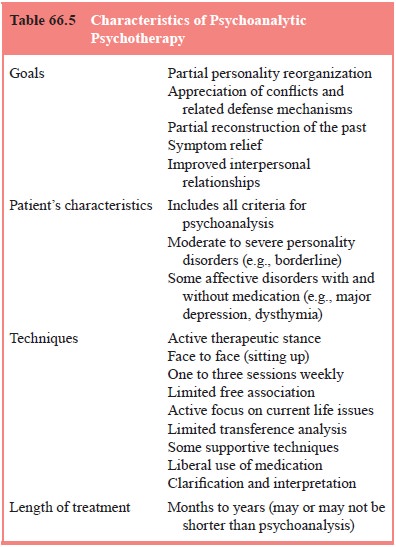Chapter: Essentials of Psychiatry: Individual Psychoanalytic Psychotherapy
Psychoanalytic Psychotherapy: Basic Technique
Basic
Technique
The
analysis of transference by the interpretation of resistance is important for
the psychoanalytic psychotherapist. To promote the patient’s examination of the
phenomena of transference and resistance, both the analyst and the therapist
are guided by prin-ciples that establish a confidential, safe and predictable
environ-ment geared toward maximizing the patient’s introspection and focus on
the therapeutic relationship. The patient is encouraged to free associate, that
is, to notice and report as well as she or he can whatever comes into conscious
awareness (Tables 66.4 and 66.5).


Therapeutic
neutrality and abstinence are related concepts. Both foster the unfolding and
deepening of the transference, as well as the opportunity for its interpretation.
The psychoanalytic psychotherapist assumes a neutral position vis-à-vis the patient’s psychological
material by neither advocating for the patient’s wishes and needs nor
prohibiting against these. The patient is en-couraged in the therapeutic
relationship to develop the capacity for self-observation. Neutrality does not
mean nonresponsive-ness; it is nonjudgmental nondirectiveness.
Abstinence refers to the position assumed by the psychoan-alytic psychotherapist of recognizing and accepting the patient’s wishes and emotional needs, particularly as they emanate from transference distortions, while abstaining from direct gratifica-tion of those needs through action. Abstinence is a principle that guards against the therapist’s gratification at the patient’s ex-pense. For example, as the treatment experience deepens into a more consolidated transference neurosis, there may be a strong tendency by the patient to experience the therapist as the impor-tant person in the patient’s life around whom the characteristic conflictual issues are manifested. By maintaining a neutral and abstinent position with respect to the patient’s needs and wishes, the psychotherapist creates a safe atmosphere for the experiencing and expression of even highly charged affects, the safety required for the patient’s motivation for continued therapeutic work. The position held by the psychiatrist is neither sterile nor overstimu-lating and promotes the establishment of a meaningful therapeu-tic relationship.
The rule
of free association dictates that the patient should verbalize to the best of
her or his ability whatever comes into awareness, including thoughts, feelings,
physical sensations, memories, dreams, fears, wishes, fantasies and perceptions
of the analyst. Whereas at first glance this requirement appears to be
unscientific, in fact, the psychiatrist and patient quickly come to appreciate
that no thought or feeling is random or irrelevant but rather that all mental
content is relevant to the patient’s emotional problems. Indeed, much
productive therapeutic work is focused on those instances when the patient is
not able to speak about what is on his or her mind.
Many
psychoanalytic psychotherapists also use the tech-nique of dream
interpretation, although recently there may be less emphasis on this. Freud
placed great emphasis on the inter-pretation of dreams because he discovered
that such a technique provided insights into the working of the unconscious. In
a simi-lar fashion, slips of the tongue, jokes, puns and some types of
forgetfulness are attended to carefully by the therapist because they are
nonsleep activities that also provide insight into the pa-tient’s unconscious
mental processes. Good technique does not necessarily include pointing out to
the patient these events each time they occur, for they may often be a source
of intense embar-rassment. Rather, the slips are noted as helpful data in
assessing the patient’s inner thoughts.
All of
these techniques are embedded in a unique manner of listening to the patient’s
verbalizations within the context of the treatment situation. In particular,
two related but specific compo-nents initially attributed to the listening
process are worthy of note. First, the concept of the evenly hovering or evenly
suspended attention implies that listening to the patient requires of the
thera-pist that he or she be nonjudgmental and give equal attention to every
topic and detail that the patient provides. It also embraces the notion that
the effective therapist is one who can remain open to her or his own thoughts
and feelings as they are evoked while listening to the patient. Such internal
responses often supply im-portant insights into the patient’s concerns.
Secondly, empathic listening is of equal importance to both parties. Empathy
permits the patient to feel understood, as well as provides the therapist with
a method to achieve vicarious introspection. Indeed, one of the major
contributions of self-psychology has been the identifi-cation of empathic
listening and interpretation (the immersion by the therapist into the
subjectivity of the patient’s experience) as basic to the methodology of
psychoanalysis and psychoanalytic psychotherapy (Kohut, 1978, 1971).
Interferences to successful empathic listening are often the product of
countertransference reactions, which should be suspected whenever, for example,
the therapist experiences irritation, strong erotic feelings, or inatten-tion
during a treatment session.
Related Topics